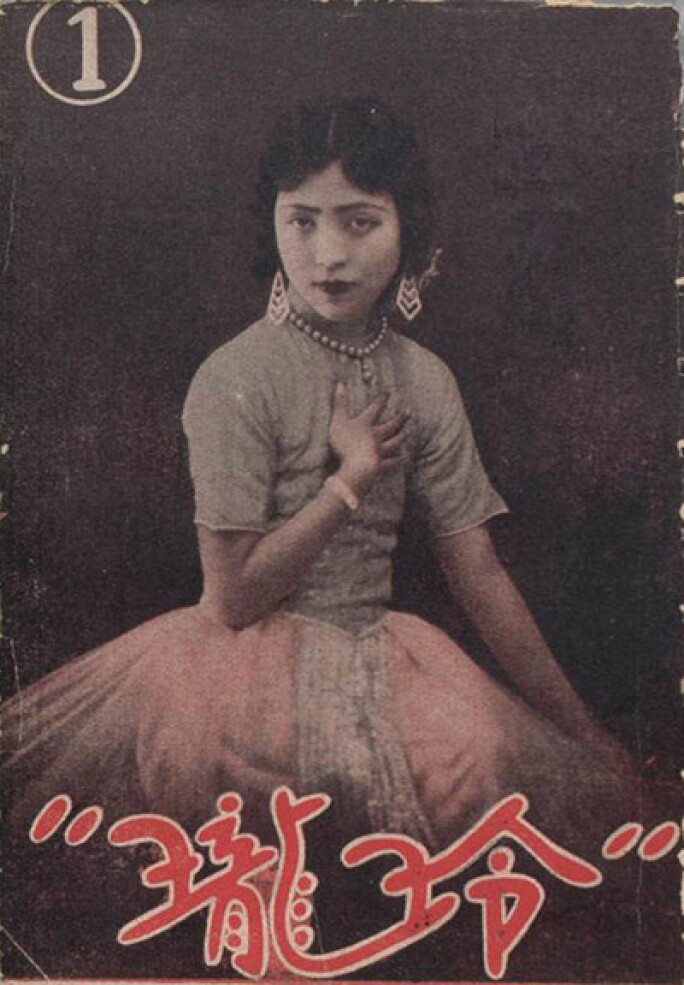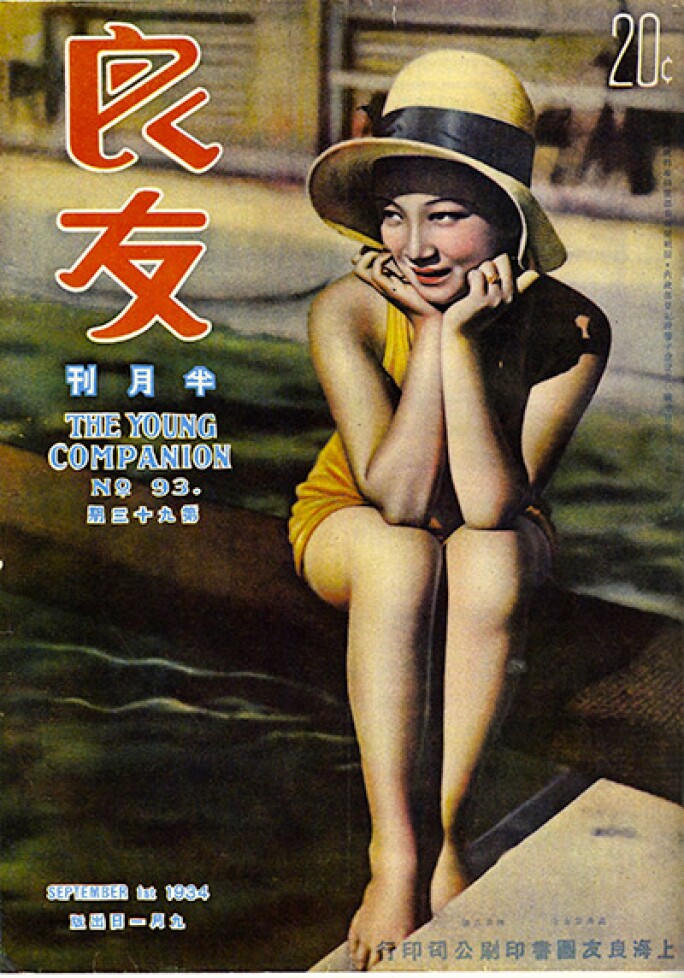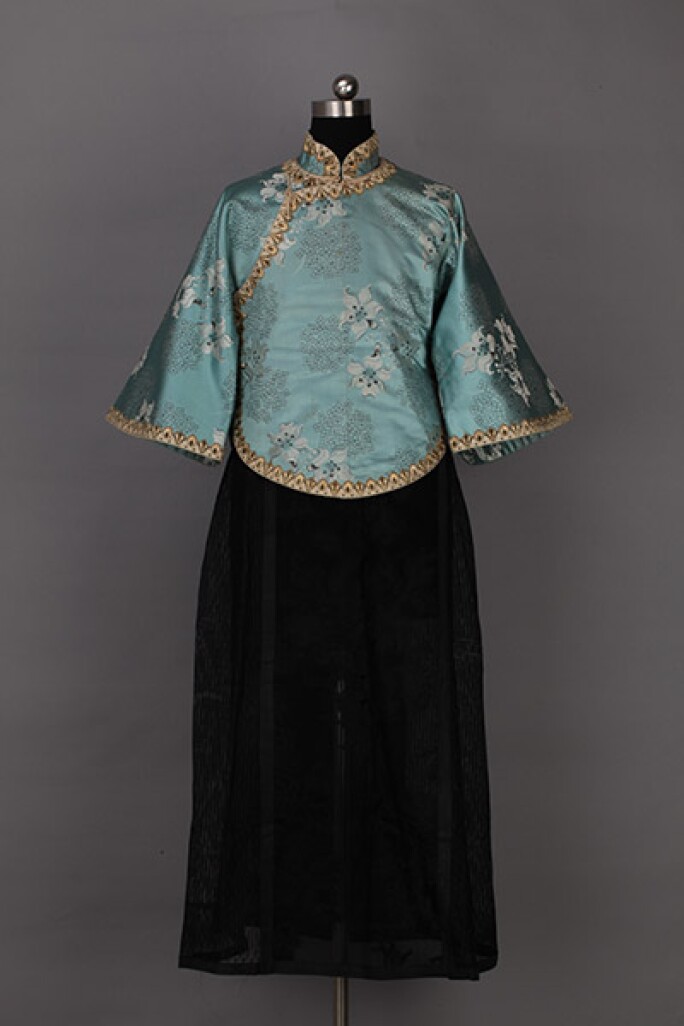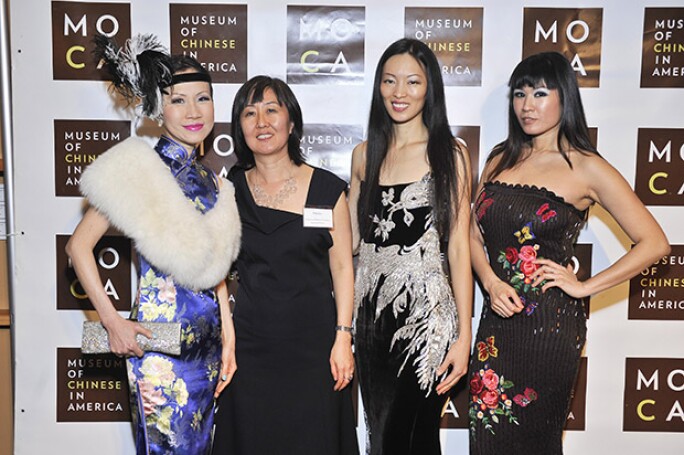NEW YORK - It’s almost sad that whenever we think about the pinnacle of modern Chinese style, we always refer to Shanghai in the 1920-30s. As if nothing has happened since.

A Shanghai socialite Zhou Shuheng posed for the cover of a 1931 issue of Lin Loon Lady’s Magazine.
It is undeniable that Shanghai in the 1920s and 30s, dubbed by the Chinese as the “Old Shanghai,” epitomized the most glamorous and most stylish of China in the last century, on par with Paris. You could be a cosmopolitan Parisian or Londoner, but you were simply not chic enough if you had not been to Shanghai. Even Wallis Simpson, twice-divorced, coarse voiced American for whom King Edward VIII of the United Kingdom and the Dominions abdicated his throne, had a brief Shanghai sojourn (1924) on her cosmopolitan resume.

A large feather fan was a chic component of a Parisian-influenced ensemble in Shanghai during the 1920s.
Established in 1843 as a treaty port, Shanghai quickly became the largest international port in China by the early twentieth century, attracting expats and Westerners who called the city “Adventurers’ Paradise.” The aura of “Old Shanghai” was derived from the convergence of the Western influences and Chinese sensitivities: rich art deco architecture and designs flaunting an international flair, profusely illustrated tabloids disseminating the latest trends and celebrity gossips, and beautiful people indulging in their legendary, alas, complicated romances.

An early 1930s qipao in silk crêpe, accentuated with metal-thread embroidery, flatters a tall and slender figure.
But nothing embodied the Old Shanghai’s unique allure more than cheongsam. And in the world of global fashion, nothing represents the quintessential “Chinese Element” more than cheongsam, known as qipao in Mandarin, with many of its primary attributes, such as high collar, side slits and hour-glass body-conscious shape being equated with the Eastern mystique. Cheongsam reached its current feminine form in the Old Shanghai. “Shanghai Glamour: New Women 1910s-40s,” which opened last night at the Museum of Chinese in America in New York, showcases twelve exquisite outfits of the period lent by China National Silk Museum in Hangzhou, with accessories, photos and magazines sourced from private collections. Harold Koda, Curator in Charge of the Met’s Costume Institute who wrote “Paris Fashion: Modernism and the East” for the catalogue that accompanies the show, kept on saying “How glamorous!” when he saw the clips of Old Shanghai movies running during the opening reception.

A velvet and metallic lace qipao from 1930s exemplifies fusion of Chinese and Western sartorial elements.
Frankly, I seldom wear cheongsam when there is a Chinese gathering. It’s too predictable. With my dark straight hair and “charming” (as I have been told) accent, I do not need another Chinese Element to exude my Chineseness.
In my prior incarnation as a Wall Street lawyer, one time I attended a cocktail reception at an international conference in Asia. The dress code called for “smart cocktail.” Out of a whim I showed up in a rose red cheongsam made of cotton eyelet fabric that I picked up in Shanghai, leaving all of my (predominantly male) colleagues and clients, who used to see me suited up in pinstripe black or blue, with their mouths agape in admiration. Wow—I suddenly realized that cheongsam was still a “turn-on” these days!

A tight-fitting long jacket with a high collar and three-quarter sleeves, worn with a pair of cropped pants, from the early 1910s.
In effect, for many Chinese ladies, cheongsam was the best way to pull off a professional look without looking macho. Ironically, despite its purported sexual appeal and association with exotic seductresses in the West, the popularity of qipao had something to do with the revolutionary history of the early twentieth century, the birth of “New Women” and related progressive causes. It embodied women’s liberation, intellectual independence and free spirits. In 2010, a popular spy TV series in China titled QIPAO told a story of a young female student turning into a political assassin during the Japanese invasion of China. Code-named Qipao, she ingratiated herself with the villain Chinese collaborator who sold himself out to the Japanese military force, taking advantage of his fetishistic collection of qipao and women who wore them.

Female stars exemplified the new healthy natural looks, gracing a 1934 cover of Youth Campanion Magazine, a bi-weekly popular at the time.
Eileen Chang (a.k.a. Zhang Ailing, 1920-1995), China’s Virginia Wolf and author of Lust, Caution and Love in a Fallen City, among others, staged most of her fiction against the backdrop of Old Shanghai, even in the stories that she wrote after emigration to the United States. According to Chang, a keen observer of the fashion from the era, qipao, or "banner gown" after the eight military banners under which the Manchus had invaded China in the seventeenth century, had always existed alongside Chinese fashions. During the Qing Dynasty (1644-1922), the last imperial dynasty of China, women of the Han descent wore two pieces (see, for instance, the 1910s grey high collar jacket with loose trousers included in the show) while the Manchu women wore a long robe. With the establishment of unity between the various peoples by the new republic, women all over the country suddenly began to wear qipao — not because they wanted to show their political allegiance to the Manchu Qing dynasty or their support for its restoration, but “because they wanted to look like men.”

This silk jacquard two-piece outfit from the early 1920s idealized the Westernized, liberated female students with intellectual flair.
The earlier version of qipao was wide and loose, concealing the figure of the wearer. With time, however, the qipao was tailored to become more form fitting and revealing. Whether you were a student, socialite, courtesan, movie star, dancing girl, housewife, artist, you walked down the street with your Shanghai attitude.

A calendar advertisement showing a young woman accessorized her qipao with plush fox shawl and an art deco style purse.
In the early 1920s, qipao was straight but already more fitted. The waistline was low, in tune with the Art Deco fashion from the 1920s in the West. The MOCA show illustrates how the history of qipao in Shanghai’s fashion statement was inextricably intertwined with the rich fabric of the Western influences such as Hollywood silver screen fashion and Parisian style. And Shanghai’s fantasy in turn inspired many of the new sartorial vocabulary in the West.

By late 1920s to mid 1930s, experimental Shanghai women wore see-through qipaos made out of diaphanous gauze fabric, as shown on a Youth Companion Magazine cover.
1930s saw the fertile interplay between the East and the West, paving the ground for the formation of the classical Shanghai style qipao, when people began to wear a western overcoat, jacket or sweater over a qipao. During the same period, qipao-making absorbed Western design elements such as turndown collar, V-neck, ruffle collar, ruffle sleeves and slit-sleeves. The introduction of bust darts, waist darts, inset sleeves and shoulder slits further played up the wearer's body shape. These all occurred when all aspects of sartorial industries were in full bloom in Shanghai. Thanks to a burgeoning textile industry with a large quantity of products imported from overseas, a wide variety of satin, silk, cotton, woolen cloth and gauze made qipao a modern statement. A good example from the show is a qipao in silk crêpe, accentuated with metal-thread embroidery, dated around 1935.

Myself with HRH Prince Edward, at a reception for The Duke of Edinburgh's International Foundation (Photo Credit: Cutty McGill).
Simultaneously revealing and concealing, qipao is an understatement about proportion and style. The highly stylized calendar advertisements from the period contained a wealth of pictorial information about the development of the history, painting, industry, products, theater arts and garments. The calendars featured stylish ladies, often in qipao and accessorized with Western-style fur coats or jewelry, chronicling the evolution history of the qipao styles. You see these women smoking cigarettes, playing golf, ballroom dancing, putting on make-ups, drinking Coca-Cola, fishing or attending to toiletry. Sometimes they donned fur-trimmed long coats (a new thing for the Chinese), sometimes they strike chest-baring poses.

I attended the opening with Helen Koh (Director of the MoCA), Ling Tan and Yilin Hsu (Photo: www.patrickmcmullan.com).
In the past few seasons, cheongsam-inspired Chinese fantasies walked down the runways for Chanel’s pre-fall 2010 Paris-Shanghai collection, Ralph Lauren’s Fall/Winter 2011 collection, Jason Wu’s Fall/Winter 2012 collection, Gucci’s Fall/Winter 2012 collection, and Emilio Pucci’s Spring/Summer 2013 collection, to name just a few.
This eternal return of the qipao elements in international fashion attests to how the Old Shanghai style remains relevant to our contemporary sensitivity. In today’s Shanghai, you can still walk down the numerous qipao specialty shops that lined the Changle Road and Maoming South Road and pick out you flight to history with a century-old fantasy.